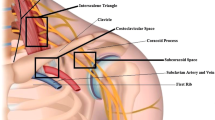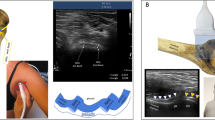Abstract
Purpose
The role of posterior capsular tightness in throwing shoulder injury has not yet been clarified. Accordingly, the influence of posterior capsular tightness on the occurrence of throwing shoulder injury was investigated.
Methods
Sixty-one shoulders with throwing injury were retrospectively reviewed, including 50 tight shoulders and 11 non-tight shoulders. Occurrence of long head of biceps (LHB) lesions, superior glenohumeral ligament (SGHL) and middle glenohumeral ligament (MGHL) injuries, type 2 SLAP lesions, and supraspinatus and subscapularis tendon injuries was compared between the tight and non-tight groups.
Results
There were LHB lesions in 8 tight shoulders and 6 non-tight shoulders, SGHL injury in 14 and 8 shoulders, and subscapularis tendon injury in 6 and 5 shoulders, respectively, showing significant differences between tight and non-tight shoulders. In contrast, MGHL injury, type 2 SLAP lesions, and supraspinatus tendon injury showed no significant differences. The SLAP lesion was located anteriorly in 6 tight shoulders, posteriorly in 5, and combined in 4 versus 0, 3, and 0 for the non-tight shoulders, respectively, so anterior SLAP lesions only occurred in tight shoulders. Similarly, anterior supraspinatus tendon injuries had a higher incidence in tight shoulders than in non-tight shoulders (19 vs 3).
Conclusions
Rotator interval lesions were frequent in non-tight shoulders, while anterior SLAP lesions and anterior supraspinatus tendon injuries were predominant in tight shoulders. The significance of posterior capsular tightness should be reconsidered.
Level of evidence
Retrospective, Level IV.




Similar content being viewed by others
References
Bennett WF (2001) Subscapularis, medial, and lateral head coracohumeral ligament insertion anatomy. Arthroscopic appearance and incidence of “hidden” rotator interval lesions. Arthroscopy 17:173–180
Bigliani LU, Codd TP, Connor PM, Levine WN, Littlefield MA, Hershon SJ (1997) Shoulder motion and laxity in the professional baseball players. Am J Sports Med 25:609–613
Burkhart SS, Morgan C (1998) The peel-back mechanism: its role in producing and extending posterior type II SLAP lesions and its effect on SLAP repair rehabilitation. Arthroscopy 14:637–640
Burkhart SS, Morgan CD, Kibler WB (2003) The disabled throwing shoulder: spectrum of pathology. Part1: pathoanatomy and biomechanics. Arthroscopy 19:404–420
Castagna A, Nordenson U, Garofalo R, Karlsson J (2007) Minor shoulder instability. Arthroscopy 25:211–215
Crokett HC, Gross LB, Wilk KE, Schwartz ML, Reed J, O’Mara J et al (2002) Osseous adaptation and range of motion at the glenohumeral joint in professional baseball pitchers. Am J Sports Med 30:20–26
Gerber C, Sebesta A (2000) Impingement of the deep surface of the subscapularis tendon and the reflection pulley on the anterosuperior glenoid rim: a preliminary report. J Shoulder Elbow Surg 9:483–490
Habermeyer P, Magasch P, Pritsch M, Schibel MT, Lichtenberg S (2004) Anterosuperior impingement of the shoulder as a result of pulley lesions: a prospective arthroscopic study. J Shoulder Elbow Surg 13:5–12
Morgan CD, Burkhart SS, Palmeri M, Gillespie M (1998) Type II SLAP lesions: three subtypes and their relationships to superior instability and rotator cuff tears. Arthroscopy 14:553–565
Nakagawa S, Mizuno N, Yoneda M, Yamada S, Gouroku T, Take Y, et al. (2008) Pain provocation test to detect posterior capsular tightness in throwing shoulder injury. Shoulder Joint 32: 461–464. (Japanese)
Nakagawa S, Yoneda M, Hayashida K, Wakitani S, Okamura K (2001) Greater tuberosity notch: an important indicator of articular-side partial rotator cuff tear in shoulders of throwing athletes. Am J Sports Med 29:762–770
Nakagawa S, Yoneda M, Mizuno N, Hayashida K, Mae T, Take Y (2006) Throwing shoulder injury involving the anterior rotator cuff: concealed tears not as uncommon as previously thought. Arthroscopy 22:1298–1303
Osbahr DC, Cannon DL, Speer KP (2002) Retroversion of humerus in the throwing shoulder of college baseball pitchers. Am J Sports Med 30:347–353
Reagan KM, Meister K, Horodyski MB, Werner DW, Carruthers C, Wilk K (2002) Humeral retroversion and its relationship to glenohumeral rotation in the shoulder of college baseball players. Am J Sports Med 30:354–360
Savoie FH, Papendik L, Field LD, Jobe C (2000) Straight anterior instability: lesions of the middle glenohumeral ligament. Arthroscopy 17:229–235
Snyder SJ, Karzel RP, Del Pizzo W, Ferkel RD, Friedman MI (1990) SLAP lesions of the shoulder. Arthroscopy 6:274–279
Yoneda M, Nakagawa S, Mizuno N, Fukushima S, Hayashida K, Mae T, et al (2006) Arthroscopic capsular release for painful throwing shoulder with posterior capsular tightness. Arthroscopy 22: 801.e1–801.e5
Conflict of interest
No author or related institute has received any financial benefit from research in this study.
Author information
Authors and Affiliations
Corresponding author
Rights and permissions
About this article
Cite this article
Nakagawa, S., Yoneda, M., Mizuno, N. et al. Influence of posterior capsular tightness on throwing shoulder injury. Knee Surg Sports Traumatol Arthrosc 21, 1598–1602 (2013). https://doi.org/10.1007/s00167-012-2107-2
Received:
Accepted:
Published:
Issue Date:
DOI: https://doi.org/10.1007/s00167-012-2107-2




